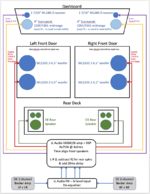OK I have to sheepishly admit that I don't understand the wiring diagram for our cars here.
I have a basic consumer level understanding of this stuff --- meaning --- I understand that each channel of sound usually has two wires, like if you use RCA plugs in the back of your home amplifier, then each RCA plug is actually 2 wires - one wire for the "tip" and one wire for the "barrel".
So I was looking to grab sounds from *after* the factory fader wheel in our cars (to feed an aftermarket amp) --- and I don't understand this wiring diagram. For two channels of sound, why are there only 3 "wires"? One of the wires is "common" for the 2 channels of sound? What? Why is this done? And, what should I know about this if I tap these to get a low level signal? I have attached the wiring diagram here with arrows pointing to the areas in question.
Thank you.

I have a basic consumer level understanding of this stuff --- meaning --- I understand that each channel of sound usually has two wires, like if you use RCA plugs in the back of your home amplifier, then each RCA plug is actually 2 wires - one wire for the "tip" and one wire for the "barrel".
So I was looking to grab sounds from *after* the factory fader wheel in our cars (to feed an aftermarket amp) --- and I don't understand this wiring diagram. For two channels of sound, why are there only 3 "wires"? One of the wires is "common" for the 2 channels of sound? What? Why is this done? And, what should I know about this if I tap these to get a low level signal? I have attached the wiring diagram here with arrows pointing to the areas in question.
Thank you.


 Actually for all of my 1990s cars (all two of them), I have ensured that they all retained only the finest of OE cassette decks in the dashboard.
Actually for all of my 1990s cars (all two of them), I have ensured that they all retained only the finest of OE cassette decks in the dashboard. 










